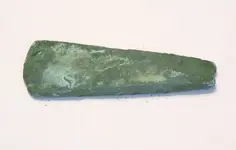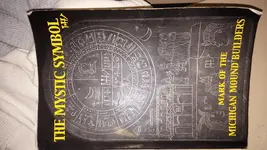Re: Who Where The "Copper Culture" People?
Michigan Copper in the Mediterranean - (Isle Royale and Keweenaw Peninsula, c. 2400BC-1200 BC)
Summary
Recent scientific literature has come to the conclusion that the major source of the copper that swept through the European Bronze Age after 2500 BC is unknown. However, these studies claim that the 10 tons of copper oxhide ingots recovered from the late Bronze Age (1300 BC) Uluburun shipwreck off the coast of Turkey was "extraordinarily pure" (more than 99.5% pure), and that it was not the product of smelting from ore. The oxhides are all brittle "blister copper", with voids, slag bits, and oxides, created when the oxhides were made in multiple pourings outdoors over wood fires. Only Michigan Copper is of this purity, and it is known to have been mined in enormous quantities during the Bronze Age.
The Geology of Copper
Copper is said to be the most common metal on the face of the Earth with the exception of iron. However, most of it is in the form of low-grade ores that require a sequence of concentration mechanisms to upgrade it to exploitable ore through a series of proto-ores. Copper ores of the "oxidized type", including the oxide cuprite, and carbonates (malachite) are generally green or blue, and reducible to copper metal by simple heating with charcoal. Ores of the "reduced type" are sulfides or sulfosalts (chalcocite, chalcopyrite, tetrahedrite), and are not readily identified in outcrops as ores; they require roasting to convert them to oxides, then reduction of the oxides to produce metal. There are a number of places in the world where copper can be found in small deposits in the pure state, but it is usually embedded in a rock matrix, from which it must be freed by intensive labor, or, today, crushed in huge volumes, and treated to obtain the metal.
The Unique Geology of Michigan Copper
Early in Earth's history, there were huge volcanic outflows over the Great Lakes area. As new sediments overlaid these flows, copper solutions were crystallizing in the Precambrian flood basalts of the lava layers. The copper had been crystallized in nodules and irregular masses along fracture zones a few inches, to many feet wide. After a billion years, about a quarter of the age of the Earth, four major glaciations ground upon the edges of the old layered basalt lava beds, and exposed some of the embedded copper (Fig.2, top drawing). Isle Royale and the Keweenaw Peninsula remained high ridges of volcanic basalt. The scraping and digging by the glaciers, followed by surface exposure of the hardest material, the metal, was followed by sluicing of the land by glacial meltwaters. This left many mineral nodules of all sizes on the surface, in the huge pine forests. This was called "float copper", as it appeared that it had "floated" to the surface. Nodules of copper were discovered shining in the surf along the shores of Isle Royale. The prolonged crystallization, followed by glacial exposure, was a unique sequence of events. When exploited, it took man from the stone age to an industrial world. The half billion pounds mined in prehistory were followed by six and a half billion pounds mined in the "industrial age" in America, starting in the late 1800s.
The Uluburun Ingots
In the excellent 30-page 2002 study by Hauptmann et al, on the "Structure and Composition of Ingots from the 1300 BC Uluburun Wreck" (Ref.54) the authors say "the cargo represents the 'world market' of bulk metal in the Mediterranean. The wreck contained 354 oxhide-shaped ingots and 121 discoid, or bun ingots, altogether 10 tons of copper (see Fig.4). Additionally a ton of tin ingots were recovered, in 120 ingots and fragments, a ratio which roughly corresponds to the ratio of copper to tin in 'classical' bronzes." The cedar hull was badly damaged by a collision with the shore, but some of the wood was preserved by the corrosion products of the copper ingots. These ingots are all now in the Museum of Underwater Archaeology, in Bodrum, Turkey, with the ingots also found in the later date Cape Gelidonya shipwreck. These are more ingots than the total in all other museums and private collections put together. Some oxhide ingots have been excavated in the Minoan ruins of Hagia Triadha in Crete (dated to 1550-1500 BC), and others have been found in Sardinia, Cyprus, the Nile Delta, Turkey and Bulgaria. Researcher Zena Halpern, (Ref.71), reports "I saw heaps of copper ingots in the Maritime Museum in Haifa, Israel". "Metal bars in the oxHide shape dating from c.1700 BC have been found at Falmouth in Cornwall", England (Ref.78). Egyptian New Kingdom tomb paintings and temple reliefs depict a great number of copper ingots, but only one has been found in Egypt, as they were consumed there. (Ref.23).
For many years, the archaeological community has thought that lead isotope studies by an Oxford group, Gale et.al.(Ref.23,35,44,56) have proved that the ingots all came from Cyprus. In 1998 the Gale group (Ref.56) reports performing "approximately one thousand [!] lead isotope analyses of ores and ingots, including about 60 Uluburun ingots". (
They did not test a single sample of Michigan copper.) The study reports that the "Uluburun ingots are greater than 99.5% pure copper".
A 32 page 1995 study by Budd et al (Ref.55), reviewed all the work to date, and says "all the oxhide ingots are composed of essentially pure copper... No meaningful conclusions on provenance can currently be drawn from a consideration of trace element data for oxhide ingots, ores, and artifacts on Cyprus or Sardinia ... It is no surprise that the only oxhide ingot mold ever found, at Ras Ibn Hani, Syria, in 1983 was surrounded by droplets bearing the same isotope signature as the vast majority of the oxhide ingots. The 1989 (Ref.35) Gale report concludes that the Aghia Triadha ingots on Crete "are certainly not made of Cypriot copper", and the copper source could not be identified. Dickinson, author of the Aegean Bronze Age (Ref. 1 ) "From outside the Aegean came ... oxhide ingots. These have all, when tested, proved to be non-Aegean metal." - Source/:
http://www.rocksandrows.com/copper-trade-4.php









